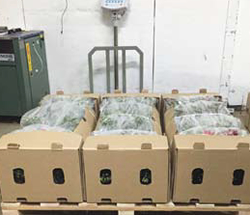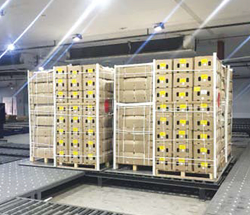
The Assignment
In September 2020, Silpack joined a group of pioneers who were tasked with transport of flowers by sea from Kenya to its main markets in Europe in an efficient and commercially viable manner.
In particular, Silpack was assigned to develop and manufacture suitable packaging for this exercise.
Why Silpack?
Silpack Industries Ltd, has been at the forefront of packaging development for flower transport in the last ten years, having developed an innovation center in Nairobi which is supported by its technical partners based in Sweden and the US.
Under the SoliQ banner, Silpack has developed cartons for air freight that have reduced costs of their customers by:
- Improving the mechanical performance of the carton and thereby reducing damage in transit
- Reducing the weight of the box to save on airfreight and reduce the carbon footprint of the package
- Developing box designs to improve pack rates and reduce the gap between the gross to net ratio of produce to packaging.
Key milestones achieved by Silpack in the last ten years include:
- Developing flower boxes which weigh between 200gsm to 400gsm lighter than its peers without compromising on mechanical performance,
- Developing flower boxes for efficient palletizing to maximize on space utilization in the air craft and raising the ULD weight from 2750 kgs to 3250 kgs,
- Ensuring material and performance consistency through the supply period, thereby allowing packaging to be a constant, and other parts of the cold chain to be challenged and improved,
- Developing high performance SFK with customization to improve flower handling and marketing opportunities for growers
 Why reinvent the wheel?
Why reinvent the wheel?
The shipment of flowers by sea was not a new idea and successfully used for the shipment of flowers from South America (Columbia and Ecuador) to the US and Europe. It was therefore important to understand whether Silpack simply reinventing the wheel, or making a progressive change.
Having studied the South American export model, and comparing it to the Kenyan situation, it become very clear that a new solution was required due to the different infrastructure, prolonged journey time, different plant varieties and consolidation to achieve critical mass.
Key considerations for Sea freight?
Understanding the various dynamics of sea freight for fresh produce, the packaging design and material selection had to be able to cope with prolonged duration of high humidity at low temperature.
The use of active controlled atmosphere (CA) reefer containers required the air flow to be regular around and in between the boxes.
Optimal space utilization within the container and reducing the use of packaging material was also critical to ensure the success of the project.
It must be remembered that at the time of development, we were at the height of COVID19 and freight disruptions were a regular occurrence and extended journey times were normal. What is a 24-day Mombasa to Rotterdam journey today, could take up to 35 days in 2020. Airfreight, though scarce, was still quite reasonable compared to the rates on offer today, therefore, a container carrying less than 6 tons of produce, would not be competitive against air-freight.
The Design and Development Various designs and prototypes were developed by Silpack and run through simulators with its partners, until the current design was firmed up.
The key features of the design include the following:
- Extra supportive edge and corners for load bearing
- Ventilations on the floor of the box
- Foldable flaps for the smooth circulation of air flow
- Size to fit maximum number of pallets and full utilization of the container
- Sturdy packaging to remove the need to use additional protection/SFK in the box and therefore increase the quantity of flowers
- 18kg payload per box
The first shipments
Feedback from the first shipments was mixed. While the boxes performed well, there was also a lot of learning to be done on the packing of flowers, box assembly and management of flower chemical solutions.
Different varieties of plants also behaved very differently.
How can it go wrong?
Shipment of flowers by sea is a very unforgiving environment.
Growers are used to using various box sizes, which are more often than not, overpacked and palletised at the airport by force or compromise by the freight forwarder. They can be pushed in between boxes or put upright where a space on the ULD avails itself as the grower is already being charged on the box dimension as calculated by the scanner.
In the sea container, there is a finite dimension and all boxes have to be uniform to maximise payload and ensure air circulation. If box types are mixed up, then the whole shipment can be compromised. Similarly, if the box is not assembled as per design, the packaging will not survive the journey and damage the produce.
The materials used to make the box are equally important. The Silpack development has been copied without too much success, because, it is not only the design but the material composition and method of manufacture that is equally important. The ingredients alone to not make a successful product without the right recipe!
It is therefore critical to ensure that packhouse teams are correctly trained by professionals on chemical treatment prior to packing, method of packing, and box assembly. If the correct protocols are maintained, growers have managed to pack 24 kgs in a box and removed all SFK from the process.
 What is the current state of affairs?
What is the current state of affairs?
According to industry players, approximately 150 to 200 containers of flowers have been shipped between January 2022 and April 2022. This is still a very small percentage compared to air freight shipments. However, the understanding and knowledge base on what it takes to ensure a successful shipment is increasing, and making the decision to move to sea freight easier.
What does the future hold?
Silpack is already working on the next version of the sea freight box to further improve the packaging solution and should be rolling it out in the next few months. The shipment of flowers by sea is no longer under trial as a concept. IT IS PROVEN, provided there are no short cuts on the protocols and the absolute minimum requirements (which are not difficult) are adhered to.
The Kenya Flower Council has intimated that they expect 50% of all flower volume to be shipped by sea by 2030. It is achievable and given the dynamics of sea freight, it is also possible to tap new markets using shipping routes which are not economical through air freight.
It is important to note that this article is focusing on the packaging element of the process. There are other protocols that need to be observed in flower treatment, consolidation, container stuffing, clearing and forwarding etc which are also critical to ensure safe and successful passage.
Parit Shah manages the development of packaging for fresh produce at Silpack.
